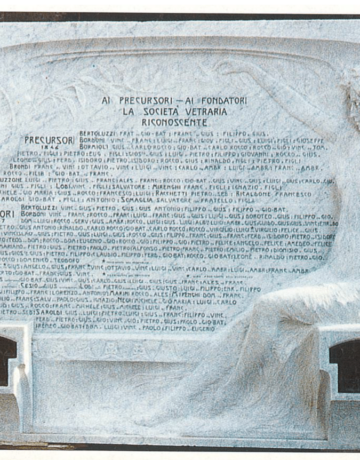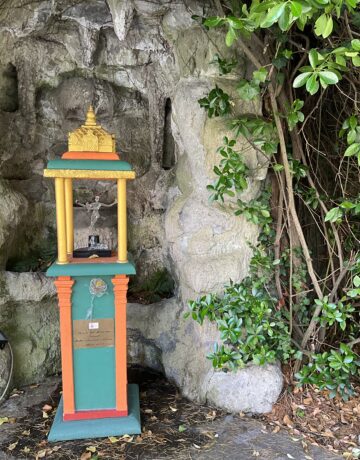Glass Art Museum: Garden Tails
 The garden space hosts various elements that tell the story of the glass art of Altare, of the Museum and its current connections with the territory.
The garden space hosts various elements that tell the story of the glass art of Altare, of the Museum and its current connections with the territory.
Along the wall of the garden you can observe some of these testimonies. A series of glass blocks that come from the demolition of the furnace of the SAVAM, an old glass factory located in Altare, is placed on the ground. These blocks called “môchi” are mere fragments of the lake of solid glass that formed inside the furnace basin, when it was finally shut down in 1992. The Museum houses some of these glass blocks in memory of the latest glass melting inside the glassworks. Next to them is placed the commemorative plaque of the foundation of the S.A.V. – Società Artistico Vetraria (Artistic Glassmaking Society), the first Italian worker cooperative, founded on Christmas night 1856, thanks to the work of the Mazzinian doctor Giuseppe Cesio.
You can still glimpse, carved in marble, the names of the precursors and founders of the S.A.V. and the coats of arms of the sixteen families that belonged to the ancient Corporation. Originally the marble plaque was located inside the glassworks in the Assembly Hall on whose ceiling the sixteen coats of arms were painted.
The Artistic Glassmaking Society was founded with the intent of guaranteeing better working conditions and had its origins in the deep moral and material crisis that had affected the glassmakers, to whom the rights were no longer guaranteed, after the suppression of the Consolato dell’Arte (Art Consulate) by the King of Savoy Carlo Felice, in 1823.

Continuing along the garden wall we come across a small glass fountain, the work of Luigi Casarini.
This work is a tribute to San Rocco, patron saint of glassmakers. Made in the early 2000s, it features the writing “tu es ce que tu bois” – “you arewhat you drink” – at the top and the shell placed near the tap recalls the object with which the Saint gave drink to the needy.
Lastly, we can find a small Hindu temple in the niche of the cave which testifies to the Museum’s relationship with the territory. In fact, not far from Altare stands the Hindu monastery Matha Gitananda Ashram, the main religious headquarters of the Unione Induista Italiana (Italian Hindu Union) where lives a monastic community based on Sanatana Dharma, the ethical and religious foundations of Hinduism. The small temple in the garden of Villa Rosa has been donated to the Museum by the Hindu community of the monastery and, to sanction this union, you can admire two small artworks in borosilicate glass: a rose, created by Costantino Bormioli, to recall the rose gardens present in the Ashram and in the Villa, and a representation of Shiva, the Lord of the dance, created by Raffaello Bormioli.
Bibliography:
Villa Rosa – Museo dell’Arte Vetraria Altarese (Villa Rosa – Glass Art Museum of Altare) curated by Valentina Fiore, guide to the Liguria Regional Museums Directorate Sagep editor, 2023
